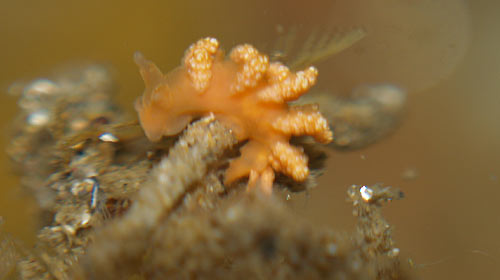Surreal and Strange Nudibranch the Pokemon of Oregon Coast Tide Pools - But Real
Published 08/04/2016 at 3:21 PM PDT
By Oregon Coast Beach Connection staff

(Oregon Coast) – They're the closet thing to Pokemon you can find in real life – and they're in Oregon coast tide pools. Some even look a lot like a Pikachu, but there's no use for a cellphone to find these. (All photos courtesy Tiffany Boothe, Seaside Aquarium. Above: the dendronotus looks more like a Pikachu than any of the nudibranchs).
They look more at home in any sci-fi movie, really. Something truly alien. Except these are real. They're freaky. And they're amazing.
One of the coolest critters to be on the lookout for is the nudibranch, which truly seem like something not even Neil DeGrasse-Tyson's “Cosmos” could've extrapolated or imagined. Some resemble Pikachu a tad, but most are far stranger than any Pokemon.
There are a large variety of these things in tide pools – and now, of course, is the season for this.

These are wild and wonderfully colorful sea slugs – or nudibranchs (pronounced with a “k” sound at the end, not a ch sound). They come in such diverse shapes, patterns and colors it is impossible to see all the configurations.
Some 3,000 different species inhabit the world’s oceans and tide pools, ranging in length from 1/8 inch to 12 inches. They also somewhat resemble the product of that esoteric mixture of art and computer algorythms called the Mandelbrot set (where computers take a fractal exercise and generate elaborate, colorful designs that are infinitely intricate).
Seaside Aquarium’s Tiffany Boothe said Flabellina triophi or dendronotus are one of the wild ones you may find in a coastal tide pool. The latter looks like a Pikachu.
“Nudibranchs are marine snails, relatives of limpets and abalone,” Boothe said. “Through evolution they have lost their shell. In fact, the name nudibranch means ‘naked gills,’ referring to the fact that their gills are on the outside of the body. While most lack shells some species have a reduced or internal shell.”
They come in all kinds of shapes and sizes – as well as colors, Boothe said. Some nudibranchs are able to blend in with their environment by means of cryptic coloration, while others brightly boast their presence to everyone.
There are about 200 species of these trippy creatures living around the Oregon coast and the Pacific Northwest.
Nudibranchs evolved from snails millions of years ago, letting go of their shells and instead growing a rough, abrasive skin that turns predators off.


Another strange and striking aspect is how they protect themselves using poisons. Some species grow their own toxins internally, but most apparently utilize toxins, stingers and such that they've eaten from other creatures. Immune to the irritants themselves, they store them in the bodies and use them when someone else tries to eat them.
They do sting, however. So you don't want to touch them. Boothe equated the pain level to that of a bee sting.
The Oregon State Parks and Recreation Department urges you to not poke, prod or pry off creatures from tide pools. Do not squish them, injure them or collect them. Prying a creature off rocks may tear off their arms and feet or destroy their organs. In the case of mature mussels, not only can they not reattach themselves – and thus die – when they’re pulled off a rock, but it can also take years for others to grow back.
Boothe said medical science is taking notice of the nudibranch, however. They are being used in cancer research in hopes of finding a cure. See the Oregon Coast Tide Pool Complete Guide for places to find them. Oregon Coast Hotels in these areas - Where to eat - Maps - Virtual Tours



More About Oregon Coast hotels, lodging.....
More About Oregon Coast Restaurants, Dining.....
Cannon Beach Lodging
Nehalem Bay Lodgings
Manzanita Hotels, Lodging
Three Capes Lodging
Pacific City Hotels, Lodging
Lincoln City Lodging
Depoe Bay Lodging
Newport Lodging
Waldport Lodging
Yachats Lodging
Oregon Coast Vacation Rentals
Oregon Coast Lodging Specials
LATEST Related Oregon Coast Articles
A special history project wants your story
Updates on Snow / Freezing Rain Next Week in Oregon, Washington - South Coast...
Forecasters say be prepared in case; freeze warning south next two nights
Cape Arago Highway Reopens, S. Oregon Coast Landmarks Like Shore Acres Access...
Shut down for a month, surprise announcement on the Coos Bay-area road
Netarts Online Nature Program Takes You Inside N. Oregon Coast Beaches
February 19 from 6:30 p.m. to 8 p.m., called Beaches, Birds, and Beyond. Oceanside events, Tillamook events, Pacific City events
Small Travel Impact from Snow in Oregon Coast Range Over Weekend - Portland G...
Brief, minor snow issues in Coast Range as Portland dries up
N. Oregon Coast's Chowder Crawl Declares Washington's Castaways Seafood Grill...
Oregon Culinary tradition names a Washington coast eatery the winner. Seaside, Astoria, Long Beach, Cannon Beach, restaurant
When Sand Dollars Move on Oregon / Washington Coast the Unexpected Can Happen
They can inadvertently create art; how sand dollars move. Marine sciences
Snow Alerts Vary Around Oregon, Washington, Coastlines - Icy Roads Possible
Winter weather advisories or warnings for most of Oregon
Back to Oregon Coast
Contact Advertise on BeachConnection.net
All Content, unless otherwise attributed, copyright BeachConnection.net Unauthorized use or publication is not permitted














































